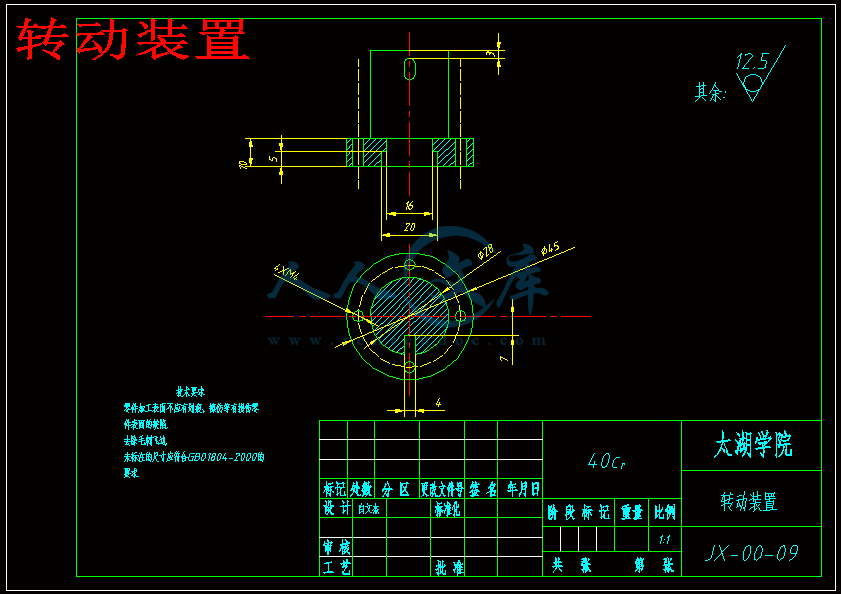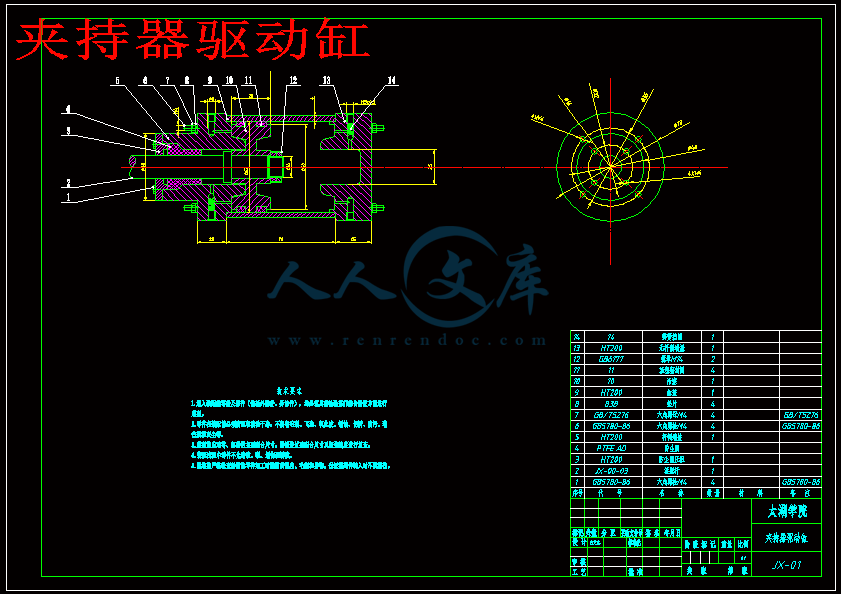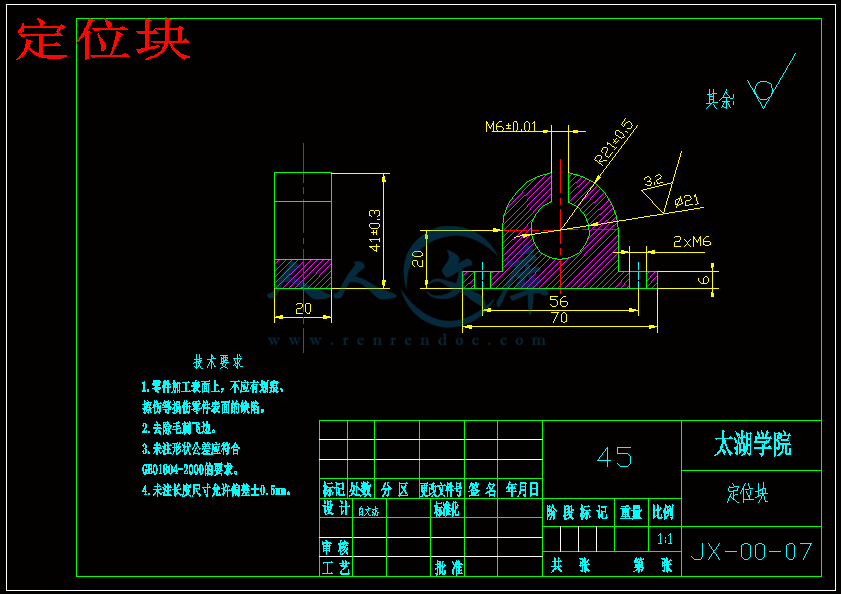【温馨提示】 购买原稿文件请充值后自助下载。
[全部文件] 那张截图中的文件为本资料所有内容,下载后即可获得。
预览截图请勿抄袭,原稿文件完整清晰,无水印,可编辑。
有疑问可以咨询QQ:414951605或1304139763
一、题目及专题:
1、题目 工业机器人设计
2、专题
二、课题来源及选题依据
工业机器人对于人类来说是当今世界最为突出的发明之一,人类对机器人深入的进行研究。在上个世纪的70年代以后,计算机技术、控制技术、传感技术和人工智能技术的迅速发展,工业机器人的研究也进入了高速发展的阶段,成为综合了计算机、控制论、机构学、信息和传感技术、人工智能、仿生学等多门学科而形成的高新技术。其本质是感知、决策、行动和交互四大技术的综合,是当代研究十分活跃,应用日益广泛的一项技术。机器人应用水平是一个国家工业自动化水平的重要标志。
本课程通过对工业机器人设计,帮助自身加深对的理解和提高对其专业知识机械原理、机械设计、材料力学机器人、传动、实体建模、有限元分析等方面的相关内容的运用能力。
本设计(论文或其他)应达到的要求:
①了解工业机器人设计原理,国内外的研究发展现状;
② 完成工业机器人设计的总体方案设计;
③完成有关零部件的选型计算、结构强度校核及气动系统设计;
④熟练掌握有关计算机绘图软件,并绘制装配图和零件图纸,折合A0不少于2.5张;
⑤完成设计说明书的撰写,并翻译外文资料1篇 。
四、接受任务学生:
机械94 班 姓名 白文杰
五、开始及完成日期:
自2012年11月12日 至2013年5月25日
摘 要
在生产过程工业机械手是模拟人手动作的机械设备,它可以替代人工搬运重物或单调,在高粉尘,高温,有毒,易燃,放射性和其他相对较差的工作环境。机器人可用于在生产过程中的自动化抓住并移动工件自动化设备,它是在生产过程的机械化和自动化,开发出一种新的类型的设备。近年来,随着电子技术,特别是计算机的广泛使用机器人的开发和生产的高科技领域已成为迅速发展起来的一项新兴技术,它更促进机器人的发展,使得机械手能更好地实现与机械化和自动化的有机结合。机械手能够代替人类完成危险、减轻人类劳动强度、重复枯燥的工作,提高劳动生产力。
本设计是关于三自由度的圆柱形机械手。利用Auto CAD软件对制件进行设计绘图。其包括夹持器、小臂、大臂和底座。明确合理的设计思路,确定了机械手工作原理并对然夹持器、气缸、步进电机、轴承进行了校核计算并附带了简图并对零件的质量、重心、惯性主轴和惯性力矩进行辅助设计计算,可以大大减轻在设计过程中繁琐计算及校核步骤。
关键字:机械手,气缸,校核。
Abstract
Industrial manipulator is the mechanical equipment which is used in the production process and simulate to the behave of hands with electrical integration. It can carry heavy objects and work in the harsh environment which is high temperature, poisonous ,full of dust, flammable and combustible monotonous and full of radioactive substance instead of people. Manipulator is a automatic device which is used in the automatic production process and it can carry and move things. It is a new device which is developed in the mechanization and automatic production process. In recent years , with the widely used of electronic technique especially the electronic computer. The research and production of robot has became a new technology which is developing rapidly in the high-tech industry . It promotes the development of manipulator. It makes the combination of the manipulator with mechanization and automation become easier . Manipulator can complete the dangerous and boring work instead of people. It can reduce labour intensity of people and raise the labour productivity .
This design is a cylindrical manipulator which is related to delta degrees of freedom. It designs and draws the picture with Auto cad software ,it includes holder, a small arm, the big arm and the base. The clear and reasonable thinking determines the working principle of the manipulator . This also checks and calculates the holder, cylinder, stepper motor and bearing. Apart from this , it contains some pictures and design and measure the quality , barycentre principal axis of inertia and force of parts. It can greatly reduce the complicated calculation and check in the design process.
Keywords: robot, cylinder, checking
目录
摘 要 III
Abstract IV
目录 V
1 绪论 1
1.1 本课题研究的内容和意义 1
1.2 国内外发展概况 1
1.3 工业机械手设计内容 2
1.4 机械手设计的作用 2
1.5 工业机械手的分类和组成 2
2 手部的设计 5
2.1 机械手设计参数和运动方案 5
2.1.1 运动方案 5
2.1.2 驱动系统和位置检测装置的选择: 5
2.2 手部设计的结构和计算 6
2.2.1 机械手的基本要求 6
2.3 手部力的计算 7
2.3.1 夹紧力的计算 7
2.3.2 手爪驱动气缸的设计 8
2.3.3 手部误差的分析 10
3 机械手臂的设计 12
3.1 机械小臂设计 12
3.1.1 小臂驱动力的计算 12
3.1.2 小臂驱动气缸的设计 13
3.1.3 气缸筒壁厚的计算 14
3.1.4 气缸的选用 14
3.1.5 校核活塞的稳定性 14
3.1.6 小臂刚度校核 15
3.1.7 端盖的连接方式及强度计算 15
3.2 大臂的结构设计 17
3.2.1 大臂的结构和要求 17
3.2.2 驱动力的计算 17
3.2.3 大臂驱动气缸的设计 17
3.2.4 气缸的选择 18
3.2.5 校核活塞的稳定性 18
3.2.6 大臂刚度校核 19
4 驱动系统设计 20
4.1 轴承的设计 20
4.1.1 轴承的选择 20
4.1.2 轴承的计算: 20
4.1.3 轴承的寿命校核: 21
4.2 电机的基本情况和选择 22
4.2.1 电机的选则与计算 22
4.2.2 注意事项 23
4.2.3 工作原理 24
4.2.4 步进电机的特点 24
4.3 谐波减速器 24
4.3.1 谐波减速器的简介 24
4.3.2 谐波减速器的设计 25
4.4 腰座的结构 26
5 总 结 28
致 谢 29
参考文献 30
附 录 31
1 绪论
1.1 本课题研究的内容和意义
机械工业是国民的基本部分。工业机械手的设计是一项综合设计与机械制造,机电工程等专业联系一起。通过这次设计提高学生的机构分析能力,机电一体化机械结构设计的设计能力提升。来学习一些生产时的设计方法。
工业机械手是近十年来发展起来的,一种高科技自动生产。这体现了人类智能和适应性,机械手能在各个环境下完成作业能力,在国民经济发展中起着重要的作用,具有很广阔的前景。近20年来,气动技术的运用领域迅速拓宽,尤其在各个生产线上的应用。可编程控制和气动驱动相结合,使整个自动化系统更高级。控制更加的灵敏,性能更佳的可靠。
工业机械手设计是机械设计,机电一体化,机械制造等我们学习的专业中一个重要的环节,是学完有关专业课和教学基础课程的一次专业的综合设计。学生的机械结构设计和分析综合能力都得到了有效的提高。通过这次学习得到了掌握生场自动化的设计技能。
经过这次设计,可以把有联系的课程(气动技术,机械设计,机械原理,测试技术,危机计算机原理等)中我们所知道的理论性知识加以运用,从而得到巩固和发展,让理论和实际得到了更好的结合。所以说机械手设计是一门比较综合的设计。
经过这次设计,培养了学生独立分析机械设计的能力,树立了正确的设计思想和思维,掌握了机电一体化一些机电产品的步骤和基本设计方法,这样为今后自动化的设计打下了良好的基础。
通过本次的机械手的设计,让学生熟练的去掌握和运用一些相关的知识,比如参考资料还有范文章结构。是学生具有一个设计人员应该具有的基本设计技能[1]。
1.2 国内外发展概况
现在对于国内的情况,机械手大部分的使用在各个领域。比如:在冷加工工业里还有在机床的加工上。当然我们在生产过程中会有很多的困难。比如说:形式复杂和环境温度过于高这些都影响着生产。但我们可以提供这方面的技术解决困难,让机械手更好的工作为了更好的得机械手的能力,我们要提高它的性能和速度。在其它行业和工业部门,也随着工业技术水平的不断提高,而逐步扩大机械手的使用。
现在对于国外在行业中运用机械手有很多。美国首先把机械手运用于搬运一些对人体具有伤害的放射性物质。国外实质上是使用的是定位控制机械手,他没有视觉上和触觉上的反馈。世界各地正在积极地研究视觉和触觉上有反馈的机械手,让他能够准确的来定位工件的位置和准确的夹持工件。为了判断机械手抓取的是否是工件,她有视觉传感器输入
三个方向的视觉的信息,因此,在计算机图形分析,以确定是否抓取工件。目前主要运用在机床,压力机的下料和横断压力机的下料,以及喷漆和点焊等作业。在国外发展机械手的趋势是加大力度研制具有某种智能能力的机械手。让其具有一定的传感的能力,对于外界的变化能够反馈,并相应的做出反应和变更。如果有一个位置稍有偏差,即是能够自我纠正,但也可以检测,强调视觉功能和触觉功能的研究。已经取得了一些成果。世界高端工业机器人,高精密,高速,多轴,轻量级的趋势。符合要求的微米和亚微米级的定位精度,它的运行速度可达到3M/S的新产品,以实现六轴负载2KG生产系统量已超过总重量为100KG。更重要的是,机器人手的柔性制造系统和柔性制造单元相结合,从根本上改变当前系统的手动操作的机械制造状态。同时,随着机器人和小型化再小型化,其应用将超过传统的机械领域,向电子,生物,生命及科学,航空和航天等高端产业方向上发展。
1.3 工业机械手设计内容
机电一体化技术是集合机械工程、传感技术、信息处理技术等形成的一种综合的技术。尽管机电一体化的产品种类比较多,但由于他们形式和复杂程度还有功能的不同,做工的机械本体部分是最基本的,必不可少的因素。工业机械手的设计在内容和知识还有深度上都是适中的。
我们所要设计的是拟定整体的方案,驱动装置和传动装置的方案。根据自由度选择和合适的参数选择合适的手部和腕部还有臂和机身的结构。完成各部分的计算。工业机械手工作装配图的设计与绘制。气压系统的设计。机械手的运动分析。最后写上说明书。
1.4 机械手设计的作用
机械手的广泛运用可以归纳为以下几方面:
1)建造轴类、盘类、环类的自动线。一般采用的都是机械手在传送带之间或机床之间传送工件。深井泵厂自动生产线在沈阳和大连轴承4轴和5轴加工自动马达线轴等,已成为国内汽车生产线。
2)在实现单机自动化方面。各种的半自动化机床都有夹紧、进刀、切削、退刀和松开等反面的功能。不过还需要人去上下料。如果实现自动化只需要一个人去看管机器。现在机械手在这方面运用的有很多。一些国产机在出厂时附带机械手,安装机器人的用户提供了条件。
3)国内大规模生产3T,5T,10T锻造锤,转一转炉下部,两个机器人放置在炉子前有一定的角度,从而使材料的自动化。
总的来说:对环境的适应性强,能代替危险的事物和对人有害的操作,长时间工作对人有害的场所,对于机械手是没有影响的。只要合理的设计,合理的选材就可以在高温、有害气体、放射性物质、灭火等环境中都能自如的工作。
机械手的持久度和耐劳性能强,可以把人们从单调的劳动中解救出来。甚至扩大了人的功能,他进行适当的维修、检修即能实现长时间的单调重复的工作,有与机械手工作精确度高,可以避免认为的操作错误。
机械手灵活性好,能适应产品的变化。因为机械手的运动程序和运动位置能够十分灵活的改变。因为他的自由度,又能提供迅速改变作业内容。在小批量生产中,起着重要的作用。采用机械手能明显提高劳动生产效率和生产成本。
1.5 工业机械手的分类和组成
按规格分类:微型的——重量在1kg以下; 小型的——重量在10kg以下 ;中型的——重量在50kg以下;大型的——重量在200kg以下。
按功能分类:
(1)简易型工业机械手。有两个固定的程序,近年来普遍采用可编程控制器组成控制系统。这种机械手气动的和液动的为主,因为这个结构简单而且价格便宜。运用于一些简单的单机搬运工作已经足够了,所以这种的工业机械手数量很多。
(2)记忆再现性工业机械手。这种机械手的移动设备通过人工领了一遍,然后记录原始的程序存储器,所以机器人可以重复上述动作。
(3)智能机械手。是由传感器控制的,具有视觉,还有触觉,还有行走功能和热觉。
按用途分类:专用机械手和通用机械手。独立的控制系统,专用机械手,这种机械手的动作固定的对象变量,可靠,适用于大批量生产和大批量生产。通用机械手的工作范围大、通用性强。适用于中和小批量生产[2]。
工业机械手是由执行机构、驱动机构和动力机构组成。如图1.1
图1.1 机械手传动机构
执行机构它主要有夹持器、臂部、腰座和行走机构等运动机构构成。
传力机构有很多的形式,比如有:滑槽杠杆式、连杆杠杆式、斜锲杠杆式、丝杠螺母式、弹簧式和重力式。
传动机构主要组成部分手臂可以有3个自由度,可以采用的是圆柱型坐标系、直角坐标系。球坐标系和多关节四种坐标系,这四种方式。圆柱型坐标占的空间比较小,工作范围也小但是他惯性大并且不能抓物体的底面。直角坐标工作范围下而且占的空间大,最关键是自由度少。球坐标和多关节式占有的空间小、惯性小吗、动力小、工作范围也小还能抓一个底面的物体,唯一的缺点就是多关节机械手结构过于复杂,一般很少用到。
驱动机构有气动、液动、电动和机动这四种方式。液动输出高,臂力可以达到1000N以上,能够实现连环的控制,是工业机械手的用途更加的广泛。气动式不仅速度快、结构简单而且成本低。有较高的定位精度但是臂力在300N以下。所以不同的场合适合用不同的驱动方式。
控制系统有连续型控制和点控制两种方式。大多数的点位控制都用的是插销板和可编程控制器和计算机来控制。用磁盘磁带等来记录程序。主要控制其坐标的位置,并注意其加速度的特性。
这边将设计圆柱型机械手,圆柱型机械手结构简单容易上手。圆柱形机械手简图1.2
`
1——手爪 2——气缸1 3——气缸2 4——气缸3 5——谐波减速器 6——步进电机
图1.2 圆柱型机械手简
这设计为具有一个指导原则。毕业设计的原则是:使命陈述为根本设计目标要求的具体设计要求,充分考虑机器人的工作环境和过程的具体要求。符合技术要求的基础上,尽可能多地具有结构简单,尽可能使用标准化,模块化的通用元件配件,以降低成本,同时提高了可靠性。本着科学,经济和满足生产要求的设计原则,还要考虑设计毕业设计的特点,在大学所学到的知识,如机械设计,机械原理,气动,电气传动与控制,,电子技术,自动控制,机械系统仿真尽可能的设计的综合运用知识,设计对巩固和加强,考虑到个人能力水平和大学水平的知识客观现实的时候,充分发挥个人的积极性,朴实的,现实做设计[3]。












 川公网安备: 51019002004831号
川公网安备: 51019002004831号